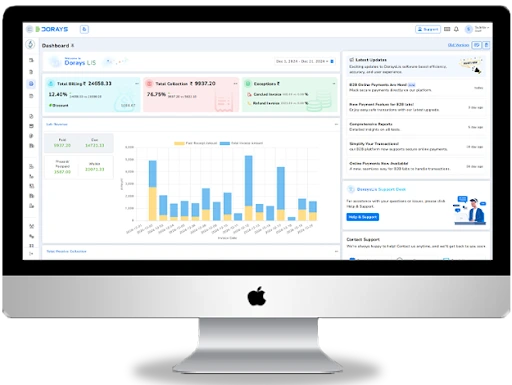Radiology departments are integral to modern healthcare. With increasing diagnostic demands and complex workflows, efficient management is essential. That’s where Radiology Information Systems (RIS) come in. RIS is no longer a niche tool for managing x-rays and scans; it has become a centralised solution for streamlining radiology workflows and handling patient information seamlessly.
But what exactly is a Radiology Information System, and how does it work? This guide will explore its features, benefits, and role in improving the operational efficiency of radiology departments.
What Is a Radiology Information System (RIS)?
A Radiology Information System (RIS) is a specialised healthcare software platform designed to manage medical imagery and associated data in radiology departments. It serves as a backbone for tracking radiology imaging orders and storing patient details, while seamlessly integrating with other healthcare systems to deliver coherent patient care.
RIS is more than just organisational software; it is a hub that connects patients, radiologists, and healthcare providers. By offering tools for scheduling, image archiving, reporting, and billing, this technology helps radiology departments elevate their operational efficiency.
Key Features and Components of RIS
To understand how RIS works, it’s essential to familiarise yourself with its core features and components. These functionalities make RIS a crucial tool for radiology departments:
1. Patient Scheduling and Registration
RIS allows healthcare providers to schedule patient appointments efficiently and track bookings. From initial registration to final discharge, RIS ensures patient demographics and clinical data are accurately stored and readily available.
2. Image Tracking and Management
RIS enables departments to track diagnostic imaging orders from initiation to completion. Each imaging study is tagged with patient information, making it easy to locate and retrieve specific images.
3. Results Reporting and Distribution
Radiologists can create, store, and distribute diagnostic reports directly through RIS. This eliminates manual errors and accelerates the sharing of patient diagnoses within the medical team.
4. Billing and Financial Management
RIS solutions include tools for managing patient billing, insurance details, and claim processing. Automated billing workflows reduce administrative bottlenecks and ensure faster revenue cycles.
5. Integration with Picture Archiving and Communication System (PACS)
By integrating seamlessly with PACS, RIS links textual data (like reports) with imaging data, offering radiologists a holistic view of each case.
Benefits of Implementing a RIS
Radiology Information Systems deliver impactful benefits to healthcare organisations. These include:
1. Enhanced Patient Care
With centralised data and streamlined communication, RIS helps reduce diagnostic errors and ensures quicker turnaround times for images and reports.
2. Time Efficiency
By automating repetitive administrative tasks and managing radiology workflows, RIS saves time for healthcare professionals to focus on patient care.
3. Data Accuracy
Manual data entry often leads to human error. RIS eliminates this issue by ensuring accurate and consistent data collection.
4. Improved Financial Processes
Automated billing workflows and insurance integration simplify revenue management, reducing outstanding balances and improving cash flow.
5. Regulatory Compliance
RIS software supports compliance with data security and medical standards, such as GDPR and HIPAA, ensuring patient data privacy.
How RIS Improves Workflow Efficiency
The efficiency of radiology workflows directly impacts the overall operations of a healthcare institution. Here are some ways RIS optimises workflow processes:
1. Reduced Downtime
RIS minimises the time spent locating imaging files and patient information, allowing radiologists to spend more time analysing cases.
2. Simplified Communication
Radiologists, technicians, and referring physicians can easily communicate findings and recommendations through the RIS, reducing the chances of miscommunication.
3. Task Automation
Administrative processes like appointment reminders, report generation, and billing updates are automated, freeing up valuable administrative hours.
4. Workflow Transparency
RIS provides a real-time overview of a department’s workflow, enabling supervisors to identify bottlenecks and improve turnaround times.
RIS Integration with Other Healthcare Systems
For healthcare organisations to operate cohesively, data silos must be minimised. Thankfully, RIS integrates with various other systems, creating an interconnected network of patient care.
1. Integration with PACS and VNA
RIS works in tandem with PACS (Picture Archiving and Communication System) and VNA (Vendor Neutral Archive) to store and manage medical images. Together, they enable quick retrieval and sharing of imaging reports.
2. Electronic Health Records (EHR)
RIS often integrates with EHR software to provide clinicians with a unified patient history. This ensures providers have access to all diagnostic data alongside clinical notes and medications.
3. Laboratory Information Systems (LIS)
RIS can also coordinate with LIS to consolidate diagnostic data across multiple disciplines for comprehensive patient care.
The Future of RIS in Healthcare
Radiology Information Systems have advanced significantly, but their evolution is far from over. The future of RIS will likely involve deeper integration of AI and machine learning technologies.
1. AI-Powered Diagnoses
RIS platforms equipped with AI capabilities will help radiologists identify patterns and interpret imaging data faster and more accurately.
2. Cloud-Based Systems
The shift toward cloud-based RIS solutions will improve scalability and make it easier for organisations to adopt cutting-edge features and updates.
3. Enhanced Data Analytics
Future RIS platforms will leverage advanced analytics to predict imaging trends and improve patient outcomes.
4. Greater Interoperability
RIS systems of the future will place even greater emphasis on interoperability, ensuring seamless connections across healthcare IT ecosystems.
Optimising Radiology with RIS
Radiology Information Systems have become a vital component of modern radiology departments. They not only improve workflow efficiency but also enhance patient care through accurate data management.
Implementing a robust RIS isn’t just an operational upgrade; it’s an investment in building a smarter, more interconnected healthcare system.
If your organisation is looking to streamline radiology workflows, ensure accurate data management, and stay ahead in today’s fast-paced healthcare environment, explore Radiology Information System solutions today.

